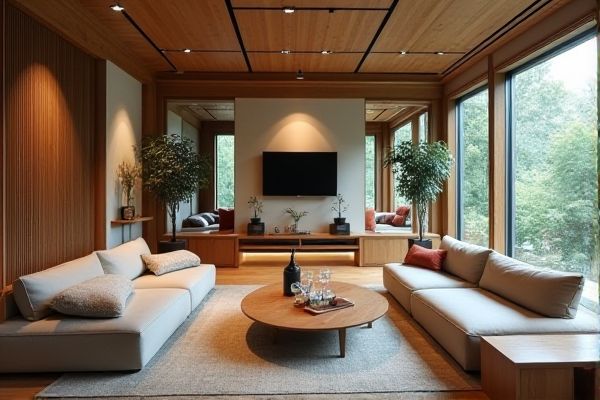
Modular seating offers flexibility and adaptability for various spaces, allowing you to rearrange or expand seating arrangements to suit changing needs, while fixed seating provides a stable, permanent solution optimized for space efficiency and durability. Discover the key differences and benefits of each option to determine which seating best fits your environment in the full article.
Table of Comparison
| Feature | Modular Seating | Fixed Seating |
|---|---|---|
| Flexibility | Highly flexible; can be reconfigured to suit different layouts and spaces | Permanent layout; limited or no reconfiguration options |
| Installation | Easy and quick to install and move | Requires professional installation; time-consuming |
| Cost | Generally lower upfront cost; potential savings in long term | Higher initial investment; durable |
| Maintenance | Easy to maintain and replace parts | More durable; repairs can be complex and costly |
| Customization | Highly customizable in size, shape, and style | Limited customization after installation |
| Use Case | Ideal for multi-functional spaces and dynamic environments | Best for fixed layouts like auditoriums and theaters |
Introduction to Modular and Fixed Seating
Modular seating offers flexible configurations with individual components that can be easily rearranged or replaced, enhancing adaptability in various environments. Fixed seating consists of permanently installed units designed for stability and uniform arrangement, commonly found in traditional auditoriums or theaters. Understanding the differences helps in selecting seating that aligns with space utilization, maintenance needs, and user experience goals.
Key Differences Between Modular and Fixed Seating
Modular seating offers flexibility by allowing customizable arrangements and easy reconfiguration to suit varying spatial needs, while fixed seating is permanently installed with a rigid layout. Modular seating saves space and adapts to different uses, making it ideal for dynamic environments, whereas fixed seating provides stability and durability for consistent, predefined seating plans. Your choice depends on whether adaptability or permanence is the priority for your space.
Flexibility and Adaptability
Modular seating offers superior flexibility and adaptability by allowing you to easily rearrange or expand seating arrangements to suit different room layouts and events. Fixed seating limits customization, often requiring costly renovations to modify existing configurations. Choosing modular seating ensures your space remains dynamic and responsive to evolving needs without significant structural changes.
Space Optimization and Layout Efficiency
Modular seating enhances space optimization by allowing flexible rearrangement to fit diverse room sizes and functions, maximizing usable area. Fixed seating often limits layout efficiency due to its permanent position, restricting adaptability to changing spatial needs. Businesses and event venues benefit from modular systems in optimizing seating capacity while maintaining comfort and accessibility.
Durability and Maintenance Considerations
Modular seating offers greater flexibility with replaceable components that simplify maintenance and extend overall lifespan, making it an efficient choice for durability. Fixed seating typically features robust, integrated construction designed for long-term use but can be costly and time-consuming to repair or replace. You should evaluate the specific environment and usage demands to determine which seating option balances durability and maintenance effectively.
Cost Comparison: Initial Investment and Long-term Value
Modular seating typically requires a higher initial investment due to its customizability and flexibility in design options, whereas fixed seating often comes with lower upfront costs but limited adaptability. Over time, modular seating offers greater long-term value by enabling reconfiguration and reuse in different layouts, reducing the need for frequent replacements and renovations. Fixed seating may incur higher maintenance and modification expenses as spaces evolve, ultimately diminishing its cost-effectiveness compared to modular alternatives.
Aesthetic Versatility and Design Options
Modular seating offers unparalleled aesthetic versatility, allowing for customizable configurations that adapt to various spatial layouts and design preferences, enhancing both functionality and style. Fixed seating, while providing a consistent and sturdy design, limits customization options and may restrict creative expression in interior design. The ability to reconfigure modular seating enables designers to experiment with patterns, colors, and materials, creating dynamic environments that fixed seating cannot achieve.
Installation and Relocation Challenges
Modular seating offers streamlined installation processes through pre-fabricated components that reduce on-site labor and time compared to fixed seating, which often requires extensive construction and anchoring. The ability to easily disassemble and relocate modular seating addresses flexibility demands in multi-purpose venues, whereas fixed seating presents significant challenges due to permanent attachment and structural dependencies. Relocation of fixed seating typically incurs higher costs, potential damage risks, and longer downtime, limiting adaptability in changing spatial configurations.
Suitability for Various Environments
Modular seating offers flexibility ideal for dynamic environments like offices, event spaces, and educational institutions, allowing you to easily reconfigure layouts to suit different activities and group sizes. Fixed seating provides stability and uniformity, making it suitable for theaters, auditoriums, and stadiums where consistent seating arrangements and maximum capacity are essential. Choosing between modular and fixed seating depends on your space's need for adaptability versus structured, permanent use.
Choosing the Right Seating Solution
Selecting the right seating solution depends on space flexibility and usage patterns, with modular seating offering customizable arrangements that adapt to changing needs, while fixed seating provides stability and a consistent layout ideal for permanent setups. Modular seating enhances user interaction and can optimize room capacity through reconfigurable components, making it suitable for dynamic environments such as offices and event spaces. Fixed seating is often preferred in auditoriums and theaters where uniformity and durability are paramount, ensuring long-term investment value.
 homyna.com
homyna.com